A rifle's journey from Belgium to Gaza
- Published
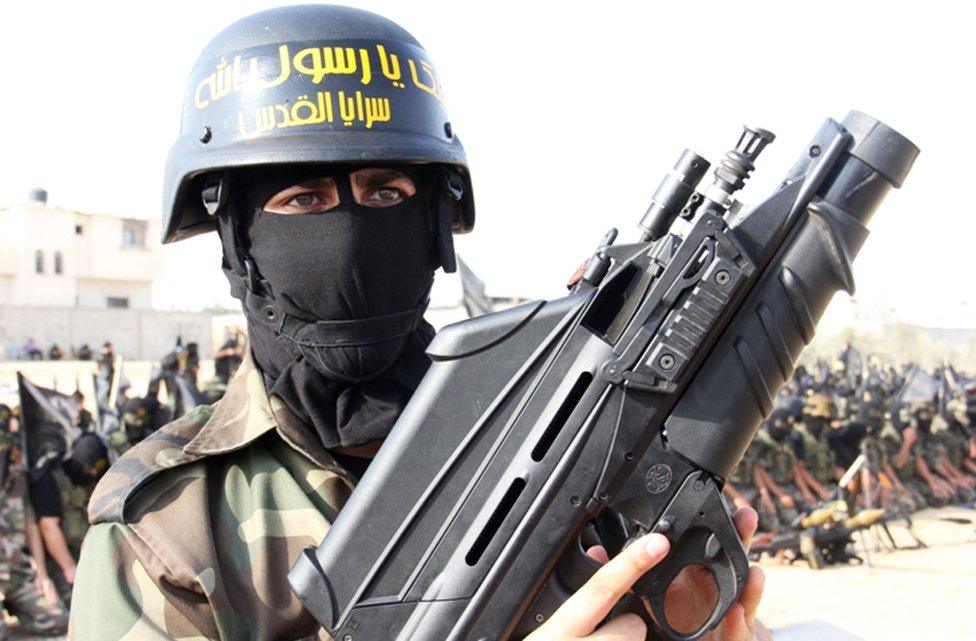
Three years ago, arms experts spotted a single advanced Belgian rifle in the hands of militants in Gaza. But how had a group listed by the EU and the US as a terrorist organisation obtained the weapon? Arms expert Nic Jenzen-Jones and the BBC's Thomas Martienssen have tracked its journey.
On 2 October 2012, the al-Quds Brigade, the armed wing of Palestinian Islamic Jihad, took to the streets of Rafah in southern Gaza to mark the 17th anniversary of a comrade's assassination in Malta by the Israeli intelligence agency, Mossad.
It's an annual event - a military parade where the militants often display their latest arms and munitions acquisitions. And in the 2012 parade, they certainly had something new.
Among the usual assortment of AK-type rifles, general-purpose machine guns from the former Warsaw Pact countries, Chinese self-loading rifles, heavy machine guns and rocket-propelled grenade launchers, were two self-loading rifles far less common in these parts - the Belgian F2000 and the Russian AK-103.
Hitherto, the F2000 and the AK-103 had rarely been seen in the hands of the same fighting force. But in the Libyan Civil War, a year earlier, the F2000 Standard with LG1 under-barrel grenade launcher had been documented in the hands of both pro-Gaddafi and, later, rebel fighters - and so had a variant of the AK-103, the AK-103-2 with three-round burst capability.
So how did these guns arrive in Libya, and how did they travel from there to Gaza? A former rebel fighter in Libya, whom we will call Ahmed, can tell part of the story.
After the fall of Tripoli to anti-Gaddafi forces in August 2011, most rebel factions turned their eyes south, towards the cities of Sirte and Sabha. One of the last few cities under loyalist control, Sabha was the next target for Ahmed and his militia unit.
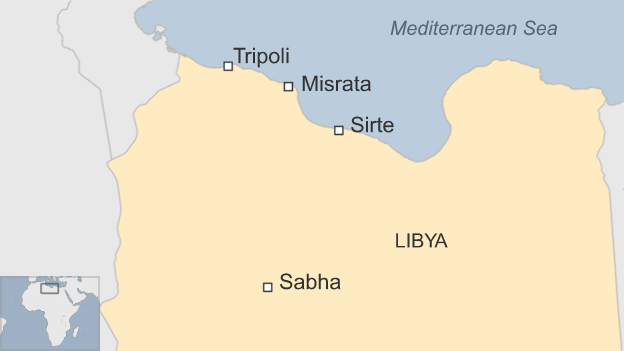
But they arrived too late. Sabha was liberated on 20 September and they only made it two days later. They had missed most of the excitement but they heard plenty of stories from a former student of about Ahmed's age, Ali. One of these was about an incident that had taken place on the southern outskirts of Sabha the previous day.
"We had a checkpoint just outside Sabha. A car came up and the window rolled down," said Ali. "The man told us he was an officer from the 32nd Brigade and we were to let them past. We didn't have any revolutionary flags at the time, so maybe they thought we were with Gaddafi's forces."
Ali captured the officer and his staff, together with his personal weapons - two modern AK-type rifles, a gold-plated handgun and two large, strange-looking rifles they referred to, mistakenly, as "the French FN".
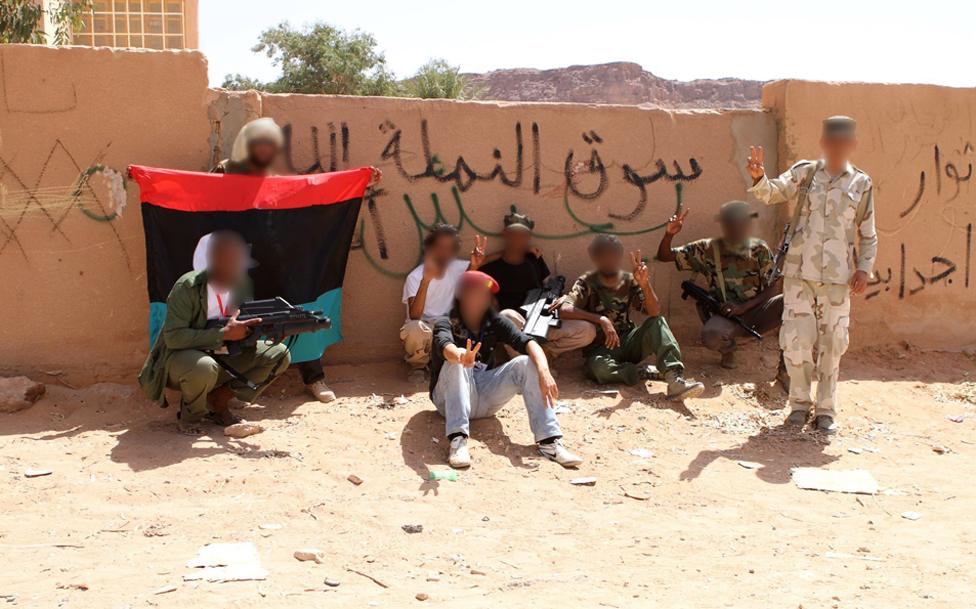
Ali's unit and their two F2000 rifles (left and centre)


An F2000 in the hands of one of Ali's fighters
The sale of the Belgian guns to the Gaddafi government had been agreed in May 2008. The manufacturer, FN Herstal, based on the outskirts of Liege, had pledged to supply 367 F2000 rifles, each fitted with an LG1 under-barrel grenade launcher, plus 367 P90 submachine guns, 367 Five-seven handguns, 50 Browning Hi-Power "Renaissance" handguns, 30 Minimi light machine guns, 2,000 FN 303 less-lethal launchers, and more than a million rounds of differing ammunition types. They would be paid more than 12m euros.
For many years the UN had banned the sale of arms to Libya, but when the country promised to destroy its chemical weapons and give up efforts to obtain other weapons of mass destruction it began to regain some standing in the international community. The UN arms embargo was lifted in 2003, and a separate EU arms embargo came to an end in 2004.
The Belgian arms were needed, according to the Libyan government, to escort an aid convoy to Sudan's troubled Darfur region. FN Herstal, Europe's largest exporter of military small arms, emphasises that the sale was entirely legal and it was far from the only European company selling arms to Libya at this time. Within five years of the European embargo being lifted the EU granted licences for sales of weapons to Libya worth about 834m euros. Companies in the UK and Italy were among those who got in on the act.
By November 2009, the weapons from the Belgian deal had all arrived in Libya, and went to equip the 32nd Reinforced Brigade, popularly known as the "Khamis" Brigade after its commanding officer, Khamis Gaddafi, the president's youngest son.
According to evidence gathered by Human Rights Watch, the brigade went on to commit a number of human rights violations, including the summary execution of some 45 detainees in Salahaddin, near Tripoli, on 23 August 2011.
Jonathan Ferguson from the Royal Armouries on the features of the F2000
Russia was also supplying arms to Libya.
In late 2003 or early 2004 - soon after the UN arms embargo was lifted - Libya had begun negotiations to buy a range of arms and munitions, including anti-tank guided weapons and man-portable air defence systems (Manpads). One of these deals included the AK-103-2 self-loading rifles.
An assessment of shipping documents, packaging, and images obtained by the intelligence consultancy Armaments Research Services (ARES), Human Rights Watch and other NGOs, indicates that Libya placed at least three orders for AK-103-2 rifles under the umbrella of one contract, issued in April 2004.
The first known order, placed in September 2004, was for some 60,000 rifles, each delivered complete with four magazines, a bayonet, cleaning kit, sling, and oil bottle. But by the time the Libyan civil war broke out in 2011, more than 200,000 of these modern Russian AK-103-2 rifles were present in the country.
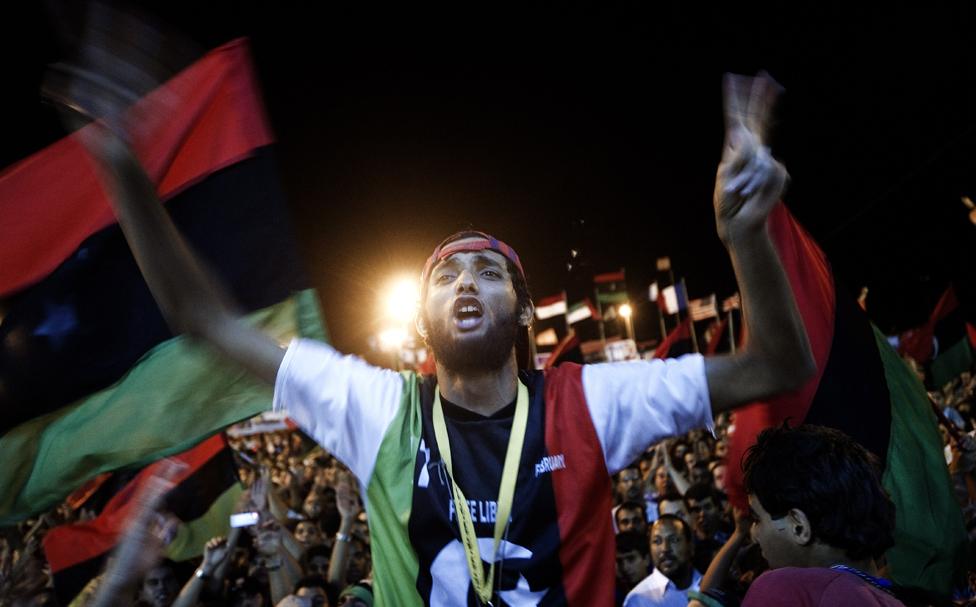
Libyans celebrating the arrest of one of Muammar Gaddafi's sons in Benghazi, 2011
Subsequently, as the fighting wound down, Ahmed, Ali and their fellow fighters handed over most of their weapons, including one of the F2000s, to the new government.
But the second of the two F2000 rifles Ali had captured was given to a black market arms dealer in Misrata called Khaled, who was collecting weapons to donate to militants in Gaza.
Contacted by ARES, through a source familiar with the Libyan arms market, Khaled confirmed he was directly responsible for a shipment to Gaza including one F2000 rifle and one AK-103-2, among other AK-103 models, all sent free of charge. "We sent them to help the people of Gaza", he said.
Just as the Belgian FN Herstal F2000 had been widely misidentified by Libyan rebels as the "French FN", the AK-103-2 was widely known in 2012 as the "Israeli Kalashnikov". Khaled and his friends took delight in supplying Palestinian militants with what they thought was an Israeli-produced weapon.

The al-Quds Brigade parade in 2012

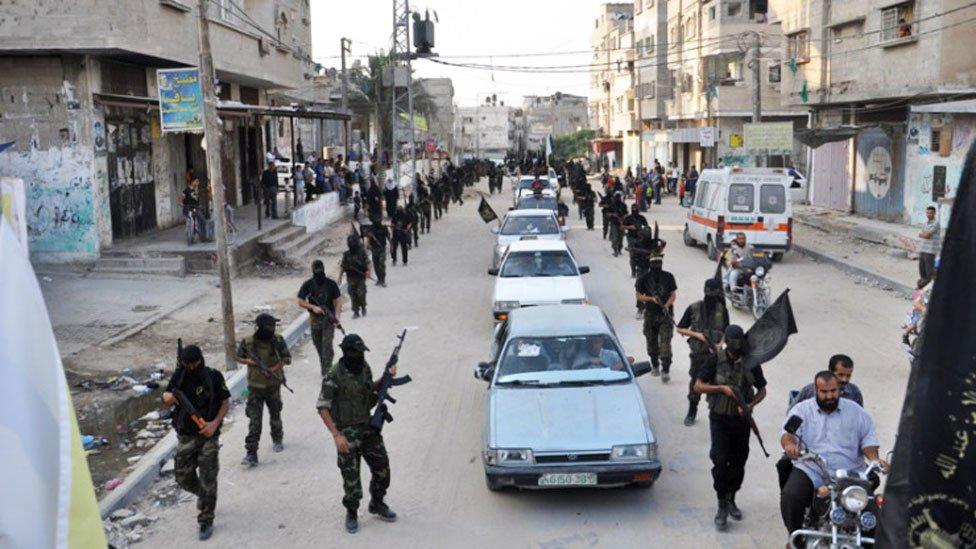
Palestinian Islamic Jihad's al-Quds Brigade has continued to parade these weapons. Both the AK-103-2 and F2000 were documented in their possession in August 2015. The Brigade recently confirmed that it still has the F2000 in its possession.
F2000 rifles have also recently appeared in the hands of militants in Egypt's Sinai Peninsula. Like those in Gaza and in Libya they were fitted with the LG1 under-barrel grenade launcher.
Unsurprisingly perhaps, considering the numbers imported to Libya, the AK-103-2 rifles remain common inside the country - they were used in the killing by Islamic State of 30 Ethiopian Christians in Libya in April - and have proliferated across the broader Middle East and North Africa region.
Hamas fighters have been pictured with them, as have other Palestinian fighters in Popular Resistance Committees and the Democratic Front for the Liberation of Palestine.
Reports from the UN Panel of Experts on Libya, meanwhile, indicate that the AK-103 has also been documented in Mali, Tunisia, and Niger.
But many other weapons, not just the F2000 and AK-103-2, were looted from Libyan stockpiles or seized by militias during the Libyan civil war. The Libyan regime was armed to the teeth, and its rapid collapse in the short and bloody conflict of 2011 left Libya as a jumble sale for militants around the world.
Nic Jenzen-Jones is director of the intelligence consultancy Armament Research Services (ARES)
Subscribe to the BBC News Magazine's email newsletter to get articles sent to your inbox.